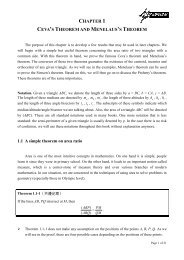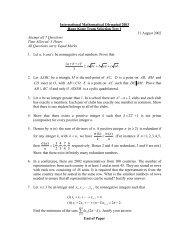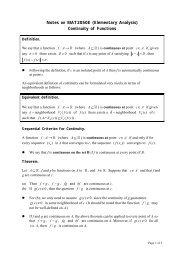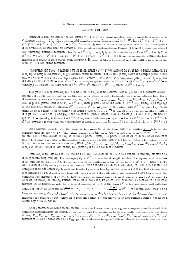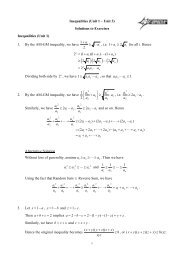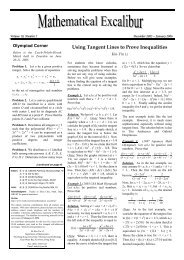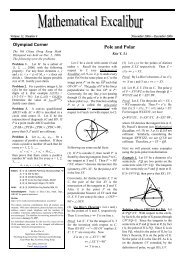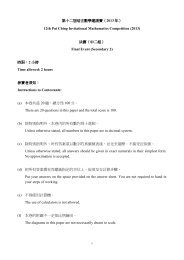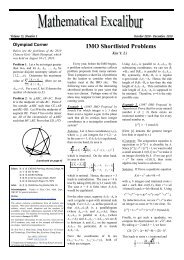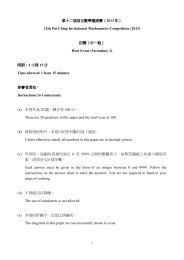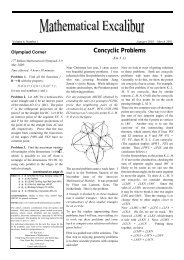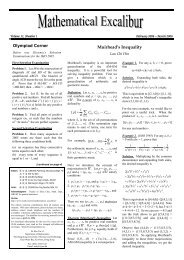An introduction to analytic number theory
An introduction to analytic number theory
An introduction to analytic number theory
- No tags were found...
You also want an ePaper? Increase the reach of your titles
YUMPU automatically turns print PDFs into web optimized ePapers that Google loves.
<strong>An</strong> <strong>introduction</strong> <strong>to</strong> <strong>analytic</strong> <strong>number</strong> <strong>theory</strong>This exposi<strong>to</strong>ry article aims <strong>to</strong> convey a taste of <strong>analytic</strong> <strong>number</strong> <strong>theory</strong> via the studyof two problems centering around the Riemann zeta function, namely the prime <strong>number</strong>theorem and the Dirichlet theorem on primes in arithmetic progressions. We shall assumesome knowledge on the reader of complex analysis (for instance, infinite products, con<strong>to</strong>urintegrals and <strong>analytic</strong> continuation) and algebra (limited <strong>to</strong> the language of group <strong>theory</strong>).1 Riemann zeta functionThe Riemann zeta function is defined byζ(s) =for all complex <strong>number</strong>s s with Re s > 1. Its relation <strong>to</strong> <strong>number</strong> <strong>theory</strong> is already seenin the following Euler’s product formula, which relates it <strong>to</strong> one of the most primitivenotions in <strong>number</strong> <strong>theory</strong>, namely prime <strong>number</strong>s:Lemma 1. For all real <strong>number</strong>s s > 1,∞∑n=11n sζ(s) = ∏ p11 − p −swhere in the product p runs through all prime <strong>number</strong>s.Proof. Every positive integer n can be written uniquely as the product of prime <strong>number</strong>s.Hence if p 1 , p 2 , . . . is a listing of all prime <strong>number</strong>s, then p e 11 p e 22 . . . runs through all positiveintegers when the exponents e 1 , e 2 , . . . independently run through all non-negative integers1
with all but finitely many being non-zero. As a result,∞∑ 1n = lim∑ ∑. . . ∑ s k→∞e 1 ≥0 e 2 ≥0 e k ≥0( ) ( ∑ 1 ∑= limk→∞ p se 1e 1 ≥0 1 e 2 ≥0n=1= limk→∞( 11 − p −s1= ∏ p11 − p −s(p e 11 p e 2p se 2) ( 11 − p −s212 . . . p e k) (1 ∑. . .2e k ≥0). . .k) s1p se kk( 11 − p −skas desired, at least formally. It is easy <strong>to</strong> justify the manipulations of the infinite seriesand products here, which we leave <strong>to</strong> the reader.))Such Euler product formula are very useful in general. There are various generalizationsof the above product formula <strong>to</strong> other zeta functions and their generalizations,called L-functions (see also Section 2.3 below). They relate the <strong>analytic</strong> object, namelythe zeta functions, <strong>to</strong> arithmetic information by means of a product involving one termat each prime. By a similar <strong>to</strong>ken, they are very useful in the study of geometric objects(like elliptic curves): this belongs <strong>to</strong> another huge area of mathematics that we shall nottake up here.As a warm-up we shall use the Euler product formula <strong>to</strong> prove the well-known fact thatthere are infinitely many primes. Indeed we shall prove a stronger quantitative assertion,namelyTheorem 2.∑where the sum runs over all prime <strong>number</strong>s p.p1p = ∞Proof. By the Euler product formula, at least for real values of s > 1,log ζ(s) = − ∑ plog(1 − p −s )where again the sum runs through all prime <strong>number</strong>s p. The Taylor series expansion ofthe logarithm says − log(1 − x) = x + O(x 2 ) for x close <strong>to</strong> zero, so for s > 1 but close <strong>to</strong>1,log ζ(s) = ∑ (p −s + O(p −2s )) = ∑ 1p + O(1).s pp2
for any f, g ∈ H. Then Ĝ is an orthonormal basis of H. In particular, for f ∈ H wedefine for all χ ∈ Ĝˆf(χ) =< f, χ >= 1 ∑f(a)χ(a);|G|thenf(a) = ∑ χ∈Ĝa∈Gˆf(χ)χ(a)for all a ∈ G.∑Again, the readers familiar with group representations will recognize 1|G| a∈G δ a asthe Haar measure on G, and H as the Hilbert space L 2 (G) with respect <strong>to</strong> this measure.Hence the above theorem is a special case of the Peter-Weyl theorem in the setting offinite abelian groups. Since for finite abelian groups G the above theorem admits a muchsimpler proof, for the convenience of readers who do not know representation <strong>theory</strong>, weshall give the simple proof in this case below (see section 2.5).Now we specialize <strong>to</strong> the case where G = (Z/qZ) × : we shall take f <strong>to</strong> be the functionon (Z/qZ) × defined by{1 if a = l (mod q)f(a) = δ l (a) =,0 for all other a ∈ (Z/qZ) ×where l is the integer that is fixed at the beginning of this section that is relatively prime<strong>to</strong> q. Then since |G| = φ(q), where φ is the Euler phi function,for all characters χ of (Z/qZ) × and thus(2) δ l (a) = 1φ(q)ˆf(χ) = 1φ(q) χ(l)∑χ(l)χ(a)for all a ∈ (Z/qZ) × . Note that both δ l (a) and χ(a) above were only defined for a ∈(Z/qZ) × , and the equality was asserted only for such a’s. Below we shall extend thedomain of definitions of the δ l ’s and the χ’s <strong>to</strong> the whole Z/qZ and see that (2) continues<strong>to</strong> hold. This will lead us <strong>to</strong> the concept of Dirichlet characters.χ2.2 Dirichlet charactersOur goal in this section is <strong>to</strong> extend (2) so that it holds for all a ∈ Z/qZ, and indicatehow this is related <strong>to</strong> the proof of (1).5
The extension of (2) is trivial; one simply extend the definitions of δ l and the χ’s bysetting them <strong>to</strong> vanish for the non-units in Z/qZ, i.e. we setand for all characters χ of (Z/qZ) × , we setδ l (a) = 0 for a /∈ (Z/qZ) × ,χ(a) = 0 for a /∈ (Z/qZ) × .The extended χ’s are called the Dirichlet characters modulo q; there are φ(q) of them.The extension of the trivial character is still denoted by χ 0 ; so{1 if a ∈ (Z/qZ) ×χ 0 (a) =0 if a /∈ (Z/qZ) × .Now (2) obviously continues <strong>to</strong> hold on all of Z/qZ, i.e.(3) δ l (a) = 1φ(q)∑χ(l)χ(a)for all a ∈ Z/qZ, where the sum is still over all characters χ of (Z/qZ) × . By abuse ofnotation, for a ∈ Z we shall also denote by δ l (a) and χ(a) the values of δ l and χ evaluatedat the equivalent class a modulo q, and clearly (3) continues <strong>to</strong> hold for all a ∈ Z. Weshall also call such χ Dirichlet characters modulo q.With this notation in mind, by (3) we can write the sum in (1) aslim∑s→1 +p≡l(mod q)χ1p = lim∑ δ l (p)s s→1 + p sp∑1= lims→1 + φ(q)χχ(l) ∑ pχ(p)p s ;here once again ∑ pdenotes sum over all primes p. Note that we have put in the powers > 1 <strong>to</strong> make sure that the sums converge absolutely so that it can be rearranged.Separating the term involving the trivial character χ 0 , we get∑p≡l(mod q)1p = 1 ∑ 1s φ(q) p + 1 ∑χ(l) ∑ s φ(q)p̸ |qχ≠χ 0 pχ(p)p s .As s → 1 + , the first term diverges <strong>to</strong> infinity by Theorem 2. If we can show that thesecond term remains bounded as s → 1 + , then it follows that (1) holds, and Dirichlet’stheorem is proved. In fact we shall prove the following:6
Theorem 6. If χ is a non-trivial character of (Z/qZ) × , then∑ χ(p)p sremains bounded as s → 1 + , where the sum is over all primes p.pThis is plausible because if χ is a non-trivial Dirichlet character modulo q, then χtakes on more than one value on the unit circle U(1), and thus in the sum ∑ χ(p)p, itp sis likely that there are cancellations that were not present in the sum ∑ 1p. This extrap scancellation will lead <strong>to</strong> the desired boundedness of the sum ∑ χ(p)pas s → 1 + .p sIn the next section we prove this theorem, using the Dirichlet L-functions.2.3 Dirichlet L-functionsTo prove Theorem 6, we imitate the proof of Theorem 2. There we made use of theEuler product formula. It turns out that there is a version of the Euler product formulainvolving the Dirichlet characters, namelyLemma 7. For any real <strong>number</strong>s s > 1 and any Dirichlet characters χ modulo q, we have∞∑ χ(n)(4)= ∏ 1n s 1 − χ(p)p −spn=1where in the product p runs through all prime <strong>number</strong>s.The interest of the lemma is of course in the case when χ is a non-trivial Dirichletcharacter; this is the case that we will apply the lemma below. The left side of the abovelemma is usually called the Dirichlet L-function. It is usually denoted L(s, χ), i.e.L(s, χ) =∞∑n=1χ(n)n s .The sum is convergent for real <strong>number</strong>s s > 1. The proof of Lemma 7 makes use of themultiplicative property of the Dirichlet characters, namelyχ(ab) = χ(a)χ(b)for all a, b ∈ Z, and is otherwise along the same line as that of the ordinary Euler’s productformula. We omit its proof.In fact both sides of the above product formula have natural <strong>analytic</strong> continuation <strong>to</strong>the half-space {Re s > 1} in the complex plane, and the equality continues <strong>to</strong> hold there.Since we shall not make use of that, we shall be contented with the above ‘real’ versionof the product formula.7
Proof of Theorem 6. Following the proof of Theorem 2, we take the logarithm of bothsides of (4). Now both sides of (4) involve complex <strong>number</strong>s since they involve non-trivialDirichlet characters. As a result we must take the complex logarithm instead of the realone. The result is, for appropiate branches of the complex logarithm, that(5) log L(s, χ) = − ∑ (log 1 − χ(p) )p s pfor all s > 1. We shall be more careful about how the branches are chosen, but arguingformally for the moment, assuming that we have the appropiate power series expansionof the right hand side of the above identity, we get(6) log L(s, χ) = ∑ pχ(p)p s+ ∑ pO(p −2s ) = ∑ pχ(p)p s+ O(1)for s > 1. Hence the desired boundedness of the sum∑as s → 1 + follows from the following theorem:pχ(p)p sTheorem 8. If χ is a non-trivial Dirichlet character modulo q, then L(s, χ) continues <strong>to</strong>a continuously differentiable function for s ∈ (0, ∞), andL(1, χ) ≠ 0.We shall prove this in the next section.To justify the formal argument given above, first we choose an appropiate branch oflogarithm for the two sides of (5). For the left hand side of (5), we define, for s > 1 andχ ≠ χ 0 ,∫ ∞L ′ (t, χ)log L(s, χ) = −s L(t, χ) dt;this is legitimate since L(t, χ) = 1 + O(e −ct ) and L ′ (t, χ) = O(e −ct ) as t → ∞. For theright hand side of (5), note that χ(p)p −s has absolute value less than 1 for all primes pand all s > 1; thus one can simply use the principal branch of logarithm for the terms onthe right hand side of (5). In particular, the power series representation is valid:()1log= − ∑ 1 − χ(p)p −s pχ(p)p s + O(p −2s ),which incidentally justifies the equality (6). To show that the equality in (5) holds, notethat since we are just taking possibly different branches of logarithm, the two sides of the8
equation differ at most by an integral multiple of 2πi that may depend on s. Write thedifference of the two sides as 2πiM(s) where M(s) is an integer for all s. Then M is acontinuous function of s that takes only integer values, and thus M is constant. Lettings → ∞, M is identically zero. Hence the two sides of (5) are equal.It thus remains <strong>to</strong> prove Theorem 8, which is the goal of the next section.2.4 Non-vanishing of L(1, χ)Let χ be a non-trivial Dirichlet character modulo q, fixed throughout this section.Proposition 9. L(s, χ) can be <strong>analytic</strong>ally continued <strong>to</strong> Re s > 0.Proof. We use summation by parts. Let s n = ∑ nk=1 χ(k) (and s 0 = 0). Then for anypositive integer N,(7)N∑n=1χ(n)n s =N∑n=1Now s n is a bounded sequence, sinceN−1s n − s n−1∑( )1= sn s nn − 1+ s Ns (n + 1) s N . sn=1q∑χ(k) = φ(q) < χ, χ 0 >= 0k=1by the orthogonality of χ and χ 0 asserted in Theorem 5; the same holds as long as thesum is over a complete residue class modulo q. It follows that |s n | ≤ q for all n ∈ N. Nextfor n ∈ N and s with Re s > 0,∣ 1∣n − 1 ∣∣∣≤ |s|s (n + 1) s n . Res+1HenceN−1∑n=1s n( 1n s − 1(n + 1) s )converges absolutely and locally uniformly for Re s > 0 as N → ∞, and this gives via (7)the desired <strong>analytic</strong> continuation of L(s, χ) <strong>to</strong> Re s > 0.Proposition 10. L(1, χ) ≠ 0.Proof. We consider two cases: the case where χ takes on some (non-real) complex values,so that χ is a (non-trivial) Dirichlet character different from χ, and the case where χ takeson only real values, i.e. when χ = χ.9
Case 1: χ ≠ χWe need the following lemma:Lemma 11. If s > 1 then(8)∏L(s, χ) ≥ 1χwhere the product extends over all Dirichlet characters χ modulo q. (In particular theproduct is real.)Proof of lemma. By the Euler product formula (5) for L-functions, if log represents theprincipal branch of the complex logarithm, then for s > 1,∏L(s, χ) = ∏ ( )∑ 1exp log1 − χ(p)p −s χχp( )∑ ∑ ∞∑ 1 χ(p) k= expk p sk χ p k=1( )∑ ∞∑ 1 ∑= expχ(p k )kp sk p k=1 χ( )∑ ∞∑ φ(q)δ 1 (p k )= exp≥ 1kp sk pwhere the last equality follows from the Fourier series expansion (3) of the function δ 1 .k=1With the lemma we now prove L(1, χ) ≠ 0 for our fixed non-trivial complex Dirichletcharacter χ. In the product in (8), all but the trivial character contribute a fac<strong>to</strong>r thatis holomorphic near s = 1. The only fac<strong>to</strong>r that blows up corresponds <strong>to</strong> the trivialcharacter χ 0 , and since by (4),L(s, χ 0 ) = (1 − p −s1 )(1 − p −s2 ) . . . (1 − p −sN )ζ(s)where p 1 , p 2 , . . . , p N is a listing of all prime fac<strong>to</strong>rs of q, it follows that the fac<strong>to</strong>r L(s, χ 0 )can only blow up like a constant multiple ofζ(s) ∼ 1s − 1near s = 1. (The fact that ζ has a simple pole at s = 1 was mentioned after the proofof Theorem 2 and will be proved in section 3.1 below.) Now if for our fixed non-trivialcomplex Dirichlet character, we have L(1, χ) = 0, then L(s, χ) vanishes up <strong>to</strong> order at10
least 1 near s = 1; the same happens <strong>to</strong> χ, since then L(1, χ) = L(1, χ) = 0. Howeverχ is a different (non-trivial) Dirichlet character modulo q from χ. Hence there are twodifferent terms in the product (8), each vanishing up <strong>to</strong> order at least 1 near s = 1. Thiskills the only possible singularity of the product, namely the one corresponding <strong>to</strong> theterm L(s, χ 0 ), and thus the product ∏ χ L(s, χ) tends <strong>to</strong> 0 as s → 1+ , contradicting (8).This shows that L(1, χ) cannot be zero, and concludes the proof in this case.Case 2: χ = χSince χ is the same Dirichlet character as χ, the above argument would not work inthis case. We shall take another route: we shall consider the sumsS k = ∑ mn≤kχ(n)(mn) 1/2where k is a positive integer and the sum is over all ordered pairs (m, n) of positive integerswhose product does not exceed k. The key is the following:Lemma 12. If χ is a real non-trivial Dirichlet character, then(a) S k = 2k 1/2 L(1, χ) + O(1) as k → ∞;(b) S k ≥ c log k for some constant c > 0.It follows that L(1, χ) cannot be zero.Proof of lemma. (a) The proof depends on two different ways of summing S k . Note thatthe sum is over the lattice points (m, n) that lie in the first quadrant of the (m, n)plane under the hyperbola mn = k. Draw the (m, n) plane such that m representthe horizontal coordinate and n the vertical coordinate. First we sum ‘vertically andhorizontally’: we write S k as⎛⎞S k = ⎝∑ ∑+ ∑ ∑⎠χ(n) = I + II.(mn)1/2Now1≤m
the L-functions. In fact again denoting ∑ nk=1 χ(k) by s n, we have by the boundednessof {s n } thatb∑n=aχ(n)n 1/2∑= b−1n=aHowever, the sum ∑ b−1n=aresult is that ∑ b−1 1n=a n 3/2get( )1s nn − 1∑b−1+ O(a −1/2 1) ≤ C1/2 (n + 1) 1/2 n + 3/2 O(a−1/2 ).n=a1can be approximated by the integral ∫ b 1dx, and then 3/2a x 3/2= O(a −1/2 ). Hence applying this <strong>to</strong> the inner sum in I, weI ≤ Ck −1/4∑ 1m . 1/21≤m
The two sums can be estimated by first summing by parts and then approximatingby integrals, in very much the same way that we tackled the inner sum in (9). Theresult is that the two terms remain bounded as k → ∞, so <strong>to</strong>gether with the estimatefor I we getS k = 2k 1/2 L(1, χ) + O(1)as desired.(b) This time we sum S k by summing along the hyperbolas; we writeS k =k∑∑j=1 mn=jχ(n)(mn) 1/2 =k∑j=11j 1/2 A jwhereA j = ∑ n|jχ(n).However,for all j, andA j ≥ 0A j ≥ 1if j is a perfect square. This can be proved as follows: first, since χ is multiplicative,A j as a function of j is also multiplicative. It follows that we only have <strong>to</strong> considerthe case where j = p N is a prime power. Now if j = p N for some prime p, then sincenow χ is assumed <strong>to</strong> take only real values (i.e. 0, 1 and −1 since the values of χ lieson U(1)), we have⎧N + 1 if χ(p) = 1N∑⎪⎨A j = χ(p) i 1 if χ(p) = −1 and N is even=.0 if χ(p) = −1 and N is oddi=0 ⎪⎩1 if χ(p) = 0, i.e. if p divides qIn any case A j ≥ 0, and A j ≥ 1 if j = p N with N even. This proves the assertionsabout A j . As a result,S k =k∑j=11j 1/2 A j ≥∑{a∈N: a 2 ≤k}1a = ∑ 1aa≤k 1/2≥ c log k,as desired. This completes the proof of the lemma, and thus completes the proof ofthe Dirichlet’s theorem.13
2.5 Representations of finite abelian groupsFinally, we prove the Peter-Weyl theorem as stated in Theorem 5 for finite abelian groups.There is a more general version of Peter-Weyl theorem for <strong>to</strong>pological groups (not necessarilyabelian or finite). Here we shall just give the proof in the simple setting of finiteabelian groups.In this section G will be a finite abelian group (group law written multiplicatively),and Ĝ will be the group of characters of G. L2 (G) will denote the complex vec<strong>to</strong>r spaceof all complex-valued functions on G, with inner product given as in Theorem 5.First we verify the orthogonality between distinct characters: If χ 1 ≠ χ 2 are bothcharacters of G, then< χ 1 , χ 2 >= 1|G|∑a∈Gχ 1 (a)χ 2 (a) =< χ 1 χ −12 , χ 0 >where χ 0 is the trivial character, and χ 1 χ −12 is a non-trivial character. Hence it suffices<strong>to</strong> verify the orthogonality between the trivial character χ 0 and a non-trivial character χ,i.e.∑χ(a) = 0a∈Gfor any non-trivial χ ∈ Ĝ, <strong>to</strong> which we now turn our attention. Let S = ∑ a∈Gχ(a). Thensince χ ∈ Ĝ is non-trivial, χ(b) ≠ 1 for some b ∈ G. Hence by change of variable,S = ∑ a∈Gχ(a) = ∑ a∈Gχ(ab) = χ(b)Swhich implies that S = 0, as desired.Next we verify that there are enough characters <strong>to</strong> span L 2 (G). Our proof is basedon a lemma in linear algebra, concerning the simultaneous diagonalization of a family ofcommuting linear opera<strong>to</strong>rs on a finite dimensional complex inner product space.First note that if χ ∈ Ĝ, then for any b ∈ G, we haveχ(ab) = λ b χ(a)for all a ∈ G, where λ b = χ(b). In other words, if T b : L 2 (G) → L 2 (G) is the opera<strong>to</strong>r givenby translation by b (i.e. given any function f on G, T b (f) is defined <strong>to</strong> be the functionsuch that T b (f)(a) = f(ab) for all a ∈ G), thenT b (χ) = λ b χfor all b ∈ G and all χ ∈ Ĝ. Hence given any b ∈ G, any character χ of G is an eigenvec<strong>to</strong>rof the opera<strong>to</strong>r T b . The converse is <strong>to</strong> a large extent true: if f ∈ L 2 (G) is an eigenvec<strong>to</strong>r14
of the opera<strong>to</strong>r T b for all b ∈ G, then there exists a family of complex constants λ b indexedby b ∈ G such thatf(ab) = λ b f(a)for all a, b ∈ G. It follows that λ b has <strong>to</strong> be f(b)/f(1), i.e.f(ab) = 1f(1) f(a)f(b)for all a, b ∈ G. Hence if in addition f(1) = 1, we have then |f(a)| = 1 for every a ∈ Gand so f is a character of G, i.e. f ∈ Ĝ. This saysLemma 13. A function f defined on G is a character of G if and only if f(1) = 1 andf is an eigenvec<strong>to</strong>r of T b for any b ∈ G.Hence our goal reduces <strong>to</strong> showing that there are enough simultaneous eigenvec<strong>to</strong>rs ofthe family of opera<strong>to</strong>rs {T b : b ∈ G} such that they span L 2 (G). The key observations arethat all these T b ’s commute, i.e.T a T b = T b T afor all a, b ∈ G, and that the T b ’s are all unitary opera<strong>to</strong>rs on L 2 (G), i.e.< T b (f), T b (g) >=< f, g >for all f, g ∈ H and all b ∈ G, which allow us <strong>to</strong> invoke the following lemma.Lemma 14. If {T i } k i=1 is a commuting family of unitary opera<strong>to</strong>rs on a finite dimensionalcomplex inner product space H, then there is a basis {f 1 , . . . , f n } of H such that each f jis an eigenvec<strong>to</strong>r of all the T i ’s, i.e. the T i ’s can be simultaneously diagonalized.This lemma applied <strong>to</strong> the family {T b : b ∈ G} of opera<strong>to</strong>rs on H = L 2 (G) allows us<strong>to</strong> assert that there is an eigenbasis {f 1 , . . . , f n } such that each f j is an eigenvec<strong>to</strong>r of allthe T b ’s. Renormalizing the f j ’s such that˜f j :=ff j (1) ,we obtain a basis { ˜f 1 , . . . , ˜f n } of L 2 (G) such that each ˜f j is a character of G, according<strong>to</strong> Lemma 13. This proves that L 2 (G) admits a basis consisting of characters of G andthus concludes the proof of Theorem 5, save that we have <strong>to</strong> verify that it is possible <strong>to</strong>renormalize the f j ’s, i.e. we are left <strong>to</strong> check that f j (1) ≠ 0 for all j. This is easy though:if f j (1) = 0 then since f j is an eigenvec<strong>to</strong>r of all the T b ’s, we havef j (b) = T b (f j )(1) = λ j,b f j (1) = 0for all b ∈ G, where λ j,b is the eigenvalue of T b corresponding <strong>to</strong> the eigenvec<strong>to</strong>r f j ; butthis says f j is identically zero, which is absurd since f j is a basis vec<strong>to</strong>r of L 2 (G). Thisproves that f j (1) ≠ 0 for all j, and we are done.15
Proof of Lemma 14. The proof is by induction on the <strong>number</strong> k of commuting unitaryopera<strong>to</strong>rs involved. When k = 1, this is the well-known fact that a unitary opera<strong>to</strong>r on afinite dimensional complex inner product space is diagonalizable. So now assume that theassertion holds for some k ∈ N and take k + 1 commuting unitary opera<strong>to</strong>r on H. FirstT k+1 is unitary, thus H decomposes in<strong>to</strong> eigenspaces corresponding <strong>to</strong> distinct eigenvalues,say H = H 1 ⊕ H 2 ⊕ . . . H m , with H j being the eigenspace of T k+1 with eigenvalue λ j . NowT 1 , . . . , T k preserve each of the H j ’s, because if v ∈ H j , then for i = 1, . . . , k,T k+1 (T i v) = T i T k+1 v = T i (λ j v) = λ j (T i v).It follows that {T 1 , . . . , T k } are commuting unitary opera<strong>to</strong>rs on each of these H j ’s, thusare simultaneously diagonalizable on these H j ’s by induction hypothesis. This gives asimultaneous diagonalization of the k + 1 opera<strong>to</strong>rs {T 1 , . . . , T k+1 } on the bigger space H,and Lemma 14 is proved.3 Prime <strong>number</strong> theoremThere are a <strong>number</strong> of different approaches <strong>to</strong> the prime <strong>number</strong> theorem, some moreelementary and others more sophiscated. Since our aim is <strong>to</strong> illustrate how analysis canbe used <strong>to</strong> study <strong>number</strong> <strong>theory</strong>, we shall present here a classical proof using complexanalysis. We shall derive the prime <strong>number</strong> theorem from properties of the Riemann zetafunction. Before that, we shall need <strong>to</strong> take a closer look at the zeta function, and inparticular investigate the zeros of the zeta function on the line {Re s = 1}.3.1 <strong>An</strong>alytic continuation of ζThe zeta function was defined by a seriesζ(s) =which converges for all complex s with Re s > 1. For a deeper understanding of the zetafunction, it is necessary <strong>to</strong> <strong>analytic</strong>ally continue <strong>to</strong> a larger region in the complex plane.There are two cus<strong>to</strong>mary ways of doing that, one via a functional equation that arisesfrom the connection of the zeta function with a modular form, namely the Jacobi thetafunction ϑ(t), and another via comparing the sum with an integral. The latter approachis more like what we have been doing in proving the non-vanishing of L(1, χ) for real χ,and despite being more elementary, it is less powerful than the first approach, for we donot get a functional equation out of it. Below we describe both approaches.∞∑n=11n s16
3.1.1 Functional equation approachHere we shall make use of the theta functionϑ(t) =∞∑n=−∞e −πn2 t(t > 0) and the Poisson summation formula, which says that for a function f defined onthe real line that satisfies suitable decay estimates, e.g.|f(x)| ≤A1 + x 2 and | ˆf(ξ)| ≤ A1 + ξ 2 ,we have(10)∞∑∞∑f(x + n) =n=−∞n=−∞ˆf(n)e 2πinxas L 1 periodic functions of x (x taking values in [0, 1]). In other words, the two waysof periodizing the function f gives the same result, and if further f is continuous, thensetting x = 0 we get∞∑∞∑f(n) = ˆf(n).n=−∞n=−∞The proof of the Poisson summation formula is not <strong>to</strong>o difficult; one simply checksthat both sides of (10) are periodic L 1 functions of x defined on [0, 1], and that theirFourier coefficients agree at every n ∈ N. The details are left <strong>to</strong> the reader.The point here is that the Poisson summation formula applied <strong>to</strong> e −πn2 telegant functional equation for ϑ, namelygives anϑ(t) = t −1/2 ϑ(1/t)for real t > 0. One just has <strong>to</strong> note that e −πt2 is its own Fourier transform, and apply thePoisson summation formula. The details are omitted.Now what has the zeta function has <strong>to</strong> do with the theta function? The connectionhere is given by the principle of subordination via the Gamma function. Recall thatΓ(s) =∫ ∞0e −t t s dttfor complex s with Re s > 0. We want <strong>to</strong> study ζ(s), which is the sum of n −s over n,using the ϑ function. So we squeeze out the term n −s from this definition of Γ, and at the17
same time create terms of the form e −πn2t : in fact by the cus<strong>to</strong>mary change of variable,we have, for Re s > 1, thatand thus( sΓ =2)∫ ∞Summing over n ∈ N we get0e −πn2t (πn 2 s/2 dtt)( sπ −s/2 n −s Γ =2)( sπ −s/2 ζ(s)Γ =2)t = πs/2 n s ∫ ∞∫ ∞0∫ ∞00e −πn2t s/2 dttt .ϑ(t) − 1 s/2 dtt2 t .e −πn2t s/2 dttt ,Break the integral in<strong>to</strong> two parts, namely ∫ 1+ ∫ ∞, and using the functional equation for0 1ϑ along with a change of variable in the first integral, we get( sπ −s/2 ζ(s)Γ =2)1s − 1 − 1 ∫ ∞s + 1(t (1−s)/2−1 + t s/2−1) ϑ(t) − 1dt2in which the integral converges for all s ∈ C and is invariant under the substitutions ↔ 1 − s. Hence if we define ξ(s) <strong>to</strong> be the right hand side of the above equality andinsist that we have( sξ(s) = π −s/2 ζ(s)Γ ,2)then we have meromorphically extended ζ <strong>to</strong> the whole complex plane, and we have thefunctional equationξ(s) = ξ(1 − s),which also serves as a functional equation for ζ upon the substitution s ↔ 1 − s.Note that ξ is holomorphic except at the simple poles s = 0 and s = 1, and from(11) ζ(s) = π s/2 1ξ(s)Γ(s/2)we see that the simple pole of ξ at s = 0 is cancelled by the simple zero of1Γ(s/2) there.Furthermore, at s = 1, Γ(1/2) = π 1/2 . As a result, ζ is now holomorphic on the wholecomplex plane, with a simple pole at s = 1 where ζ behaves likeζ(s) ∼ 1s − 1 .This settles the questions about the singularities of ζ.The zeros of ζ are far more fascinating. From (11) one sees immediately that ζ(s) = 01whenever s is a negative even integer, for vanishes there. These are called the trivialΓ(s/2)zeros of ζ, and they are the only zeros of ζ off the critical strip {0 ≤ Re s ≤ 1}. This18
is because ζ is nowhere zero on {Re s > 1}, and thus so is ξ; then by the functionalequation, ξ has no zeros in the region {Re s < 0} as well, so by (11) one sees that the only1possible zeros of ζ off the critical strip comes from those of , and they are preciselyΓ(s/2)the negative even integers. The famous Riemann hypothesis asserts that the onlynon-trivial zeros of ζ (i.e. those lying in the critical strip) lie on the line Re s = 1. This 2has remained open for more than a hundred years, despite the effort of many first ratemathematicians. In fact the zeros of ζ inside the critical strip has been of great interestsince Riemann’s famous memoir in 1859. The proof of the prime <strong>number</strong> theorem thatwe shall give involves showing that ζ has no zeros on the line Re s = 1, and in fact it wasknown that the prime <strong>number</strong> theorem is equivalent <strong>to</strong> the fact that ζ does not vanish onthe line Re s = 1.3.1.2 Integral approachNext we describe the integral approach of <strong>analytic</strong>ally continuing ζ. Here we comparethe partial sums of ζ(s) <strong>to</strong> an integral, and continue ζ <strong>to</strong> the region {Re s > 0}. Moreprecisely, we write, for Re s > 1 and N ∈ N, that(12)whereN−1∑n=1∫1 Nn − sδ n (s) =1∫ n+1nN−11x dx = ∑δ s n (s),n=1( 1n s − 1 x s )dx.Note that each δ n is an entire function of s, and satisfies an estimate∫ n+1|δ n (s)| ≤1∣n − 1 ∣ ∣∣∣dx ≤|s|s x s nRe s+1by the mean value inequality applied <strong>to</strong> x ↦→ x −s . HencenH(s) :=∞∑δ n (s)converges locally uniformly on the region {Re s > 0}, and defines a holomorphic functionthere. Letting N → ∞ in (12), we haven=1ζ(s) = 1s − 1 + H(s)for Re s > 1. However, since the right hand side of this equation is defined and meromorphicon {Re s > 0}, it provides an meromorphic continuation of ζ <strong>to</strong> this larger region,1and it is again readily seen that ζ has a simple pole at the point s = 1, as we haves−1observed using the functional equation approach.19
3.2 Estimates of ζ and ζ ′Our goal now will be <strong>to</strong> establish some estimates of ζ (and its derivative) on the lineRe s = 1, which is a key <strong>to</strong> proving the prime <strong>number</strong> theorem. This will be based on theintegral approach of continuing ζ that we described above.Lemma 15. For each σ 0 ∈ (0, 1] and each ε > 0, there exists a constant c ε such that(a) |ζ(s)| ≤ c ε |Im s| 1−σ 0+ε for all s with Re s ≥ σ 0 and |Im s| ≥ 1.(b) |ζ ′ (s)| ≤ c ε |Im s| ε for all s with Re s ≥ 1 and |Im s| ≥ 1.Proof. To see that this is true, first observe that the second assertion follows from the firstby Cauchy’s estimates: if Re s ≥ 1 and |Im s| ≥ 1, then given ε > 0, Cauchy’s estimatefor holomorphic functions gives|ζ ′ (s)| ≤ 1ε/2 max |ζ(t)|,|t−s|=ε/2so applying (a) with σ 0 ≥ 1 − ε/2 and ε/2 in place of ε we have|ζ ′ (s)| ≤ c ε/2(|Im s| + ε/2) 1−(1−ε/2)+ε/2ε/2= O(|Im s| ε )with an implicit constant depending on ε. For the first assertion it suffices <strong>to</strong> considerthe case where ε is small, say 1 − σ 0 + ε < 1. In this case the inequality follows from twoestimates of δ n (s), one being the estimate|δ n (s)| ≤ |s|nRe s+1which we already alluded <strong>to</strong>, the other being|δ n (s)| ≤ 2n Re swhich holds trivially by estimating the integrand of the integral defining δ n . Now takinga geometric mean of these two estimates, for any η ∈ [0, 1], we have|δ n (s)| ≤Taking η = 1 − σ 0 + ε, we have( |s|n Re s+1 ) η ( 2n Re s ) 1−η≤ 2|s|ηn σ 0+η .|δ n (s)| ≤ C |Im s|1−σ 0+εn 1+ε .20
This is because if Re s ≤ 1 + ε, then|s| ≤ √ (1 + ε) 2 + |Im s| 2 ≤ |Im s| √ (1 + ε) 2 + 1while if Re s ≥ 1 + ε the estimate is trivial:|δ n (s)| ≤ 2n Re s ≤ 2n 1+ε ≤ 2|Im s|1−σ 0+εn 1+ε .Hence by (12),|ζ(s)| ≤1∣s − 1∣ + C|Im s|1−σ 0+ε∞∑n=11n 1+ε ≤ c ε|Im s| 1−σ 0+εas desired.We shall need just one more estimate of ζ on the line {Re s = 1}, this time from below.This is really a quantitative way of saying that ζ has no zeros on Re s = 1 (note that ζblows up near the pole s = 1), and in fact if one examines the proof that follows, one willsee that we have actually shown that ζ(s) ≠ 0 on the line Re s = 1.Lemma 16. For every ε > 0, there exists c ε such thatfor all s with Re s ≥ 1 and |Im s| ≥ 1.1ζ(s) ≤ c ε|Im s| εProof. First observe thatlog |ζ 3 (σ)ζ 4 (σ + it)ζ(σ + 2it)| ≥ 0for all real σ > 1 and real t. This is because by the Euler product formula, for Re s > 1,log ζ(s) = ∑ p( ) 1log= ∑ 1 − p −s p∑mp −msm∞ = ∑c n n −swhere c n = 1/m if n is a prime power with n = p m and c n = 0 otherwise. It follows thatfor σ > 1 and t is real, thenlog |ζ 3 (σ)ζ 4 (σ + it)ζ(σ + 2it)|n=1=3Re log ζ(σ) + 4Re log ζ(σ + it) + Re log ζ(σ + 2it)= ∑ nc n n −σ (3 + 4 cos θ n + cos 2θ n )21
where θ n = t log n. However, c n ≥ 0 for all n, and 3 + 4 cos θ + cos 2θ = 2(1 + cos θ) 2 ≥ 0for all real θ. Thuslog |ζ 3 (σ)ζ 4 (σ + it)ζ(σ + 2it)| ≥ 0as desired.From this we prove the lemma: note now for σ > 1 and |t| ≥ 1, we have|ζ 3 (σ)ζ 4 (σ + it)ζ(σ + 2it)| ≥ 1.Hence for σ large, using Lemma 15, we have|ζ(σ + it)| ≥ c −1ε |ζ(σ)| −3/4 |2t| −ε/4 ≥ c ′ ε|t| −ε/4 .The inequality we want <strong>to</strong> prove follows easily from this.For σ close <strong>to</strong> 1, since zeta function has simple pole at 1, we have(13) |ζ(σ + it)| ≥ c −1ε |ζ(σ)| −3/4 |2t| −ε/4 ≥ c ′ ε(σ − 1) 3/4 |t| −ε/4 .If σ − 1 ≥ A|t| −5ε for some constant A (the value of A <strong>to</strong> be specified below), then we arein good shape, and|ζ(σ + it)| ≥ c ′′ε|t| −4εas desired. Hence it suffices <strong>to</strong> consider the case where σ − 1 < A|t| −5ε . However, if this isthe case, then we can first choose an ˜σ such that ˜σ > σ, and ˜σ − 1 = A|t| −5ε . Then sincewe have by (13) that|ζ(σ + it)| ≥ |ζ(˜σ + it)| − |ζ(σ + it) − ζ(˜σ + it)|,|ζ(σ + it)| ≥ c ′ ε(˜σ − 1) 3/4 |t| −ε/4 − |ζ(σ + it) − ζ(˜σ + it)|.Applying mean value theorem, the last term in absolute value is estimated by|ζ(σ + it) − ζ(˜σ + it)| ≤ c ′′′ε |˜σ − σ||t| ε ≤ c ′′′ε (˜σ − 1)|t| εusing the estimate for ζ ′ in Lemma 15. Hence|ζ(σ + it)| ≥ c ′ ε(˜σ − 1) 3/4 |t| −ε/4 − c ′′′ε (˜σ − 1)|t| ε .Set now A = (c ′ ε/(2c ′′′ε )) 4 and using the fact that ˜σ − 1 = A|t| −5ε , we have the first termon the right hand side exactly equal <strong>to</strong> 2c ′′′ε (˜σ − 1)|t| ε . Henceas was <strong>to</strong> be shown in this case as well.|ζ(σ + it)| ≥ c ′′′ε (˜σ − 1)|t| ε ≥ c ′′′′ε |t| −4ε22
3.3 Chebyshev’s ψ functionHaving unders<strong>to</strong>od more the zeta function, now we turn <strong>to</strong> the proof of the prime <strong>number</strong>theorem. We shall need two auxillary functions. The first one is the Chebyshev’s ψfunction, defined for real x byψ(x) = ∑log pp m ≤xwhere the sum is over all prime powers p m not exceeding x. It is readily seen thatψ(x) = ∑ ⌊ ⌋ log xlog plog pp≤xwhere here the sum is over all primes p not exceeding x. The second one is the integralof ψ, which we denote by ψ 1 :ψ 1 (x) =∫ xThe following notation will be adopted: we write<strong>to</strong> meanHence the prime <strong>number</strong> theorem says that1f(x) ∼ g(x)ψ(t)dt.f(x)limx→∞ g(x) = 1.π(x) ∼xlog x .To prove the prime <strong>number</strong> theorem, we make a series of reductions. First we haveTheorem 17. π(x) ∼xlog xif and only if ψ(x) ∼ x.Proof. Note thatψ(x) ≤ ∑ p≤xlog xlog p = π(x) log x,log pand that for all α ∈ (0, 1),ψ(x) ≥∑log p ≥ (π(x) − π(x α )) log(x α ) ≥ α(π(x) − x α ) log x,x α
It follows that if ψ(x) ∼ x, then letting x → ∞ in the above estimate, we get1 ≤ lim infx→∞π(x)xlog x≤ lim supx→∞π(x)xlog x≤ 1 αfor all α ∈ (0, 1), and letting α → 1 − , we get π(x) ∼a similar fashion.x . One can prove the converse inlog xNext we note thatTheorem 18. ψ(x) ∼ x if and only if ψ 1 (x) ∼ x 2 /2.Proof. This is because for any β > 1,ψ(x) ≤1(β − 1)x∫ βxxψ(t)dt =1(β − 1)x (ψ 1(βx) − ψ 1 (x)),the first inequality following from the fact that ψ is an increasing function of x. It followsthatψ(x)x ≤ 1 (ψ1 (βx)β − 1 (βx) 2 β2 − ψ )1(x),x 2and if ψ 1 (x) ∼ x 2 /2 then letting x → ∞ we getLetting β → 1 − we getlim supx→∞ψ(x)x ≤ 1 ( 1β − 1 2 β2 − 1 )2lim supx→∞ψ(x)x ≤ 1.Similarly, this time using the fact that for 0 < α < 1,we getψ(x) ≥assuming ψ 1 (x) ∼ x 2 /2.similarly.1(1 − α)x∫ xαxψ(t)dt =lim infx→∞≤ 1 (β + 1).21(1 − α)x (ψ 1(x) − ψ 1 (αx)),ψ(x)x ≥ 1It follows that ψ(x) ∼ x, and the converse can be proved24
3.4 Proof of the prime <strong>number</strong> theoremAccording <strong>to</strong> the results in the last section, <strong>to</strong> prove the prime <strong>number</strong> theorem it suffices<strong>to</strong> prove ψ 1 (x) ∼ x 2 /2. This is what we shall aim at now. Here more complex analysiscomes in. First we relate ψ 1 <strong>to</strong> the zeta function, so that we can make use of our knowledgeof ζ that we gathered in the previous sections. This is done via a magic identity:Lemma 19. For all real c > 1,(14) ψ 1 (x) = − 1 ∫ c+i∞x s+1 ζ ′ (s)2πi c−i∞ s(s + 1) ζ(s) ds,the con<strong>to</strong>ur integral being upwards along the vertical line Re s = c.Proof. We have on one hand the ψ 1 function, and on the other the ζ function. To makethe two ends meet, we use the Λ function, defined for n ∈ N by{log p if n = p k for some prime p and some k ≥ 1Λ(n) =.0 otherwiseFirst,ψ(t) = ∑∞∑Λ(n) = Λ(n)f n (t)1≤n≤tn=1where f n is the characteristic function of the interval [n, ∞). Henceψ 1 (x) =∫ xψ(t)dt =∞∑Λ(n)∫ xf n (t)dt = ∑1n=1 11≤n≤xΛ(n)(x − n).Next, taking the logarithmic derivative of the Euler product formula, we get− ζ′ (s)ζ(s) = ∑ p∑mlog pp ms= ∞∑n=1Λ(n)n s .We would like <strong>to</strong> plug this in<strong>to</strong> the right hand side of the desired identity and evaluatethe con<strong>to</strong>ur integrals. The relevant con<strong>to</strong>ur integrals are given by the following lemma.Lemma 20. If c > 0 then∫ {1 c+i∞a s2πi c−i∞ s(s + 1) ds = 0 if a ∈ (0, 1],1 − 1/a if a ≥ 1the integral taken along the vertical line Re s = c.25
Assuming this for the moment, we see thatproving Lemma 19.− 1 ∫ c+i∞x s+1 ζ ′ ∞(s)2πi c−i∞ s(s + 1) ζ(s) ds = x ∑n=1= x ∑1≤n≤x= ψ 1 (x),Λ(n) 12πiΛ(n)∫ c+i∞c−i∞(1 − n x(x/n) ss(s + 1) ds)Hence it suffices now <strong>to</strong> prove the con<strong>to</strong>ur integral in Lemma 20.Proof of Lemma 20. Indeed the con<strong>to</strong>ur integral can be evaluated by residue theorem. Ifa ≥ 1, then for T >> 0, replace the con<strong>to</strong>ur by Γ T = L 1 + C 2 + L 3 , where L 1 is thevertical line from c − i∞ <strong>to</strong> c − iT , C 2 is the half circle centered at c and of radius T thatlies <strong>to</strong> the left of Re s = c, and L 3 is the vertical line from c + iT <strong>to</strong> c + i∞. The residuethat one gains this way (at the poles s = 0, −1) is precisely 1 − 1/a, and as T → ∞ thenew con<strong>to</strong>ur integral tends <strong>to</strong> zero (here one uses that a ≥ 1). This proves the secondpart of the assertion in Lemma 20. The other part is proved similarly, except that thistime one has <strong>to</strong> replace the con<strong>to</strong>ur by ˜Γ T which one obtains by reflecting Γ T along theline Re s = c. That this is necessary is due <strong>to</strong> the fact that one needs this <strong>to</strong> argue thatthe con<strong>to</strong>ur integral along the new con<strong>to</strong>ur tends <strong>to</strong> zero as T → ∞, and when a ∈ (0, 1]this can only be achieved by using the con<strong>to</strong>ur ˜Γ T . The details are left <strong>to</strong> the reader.We shall now use the magic identity in Lemma 19 <strong>to</strong> finish the proof of the prime<strong>number</strong> theorem. We will verify that ψ 1 (x) ∼ x 2 /2 using Lemma 19 and the estimates insection 3.2. The idea is <strong>to</strong> shift the con<strong>to</strong>ur integral <strong>to</strong> from Re s = c (c > 1) <strong>to</strong> Re s = 1,so that the power of x in the integrand of (14) gets closer <strong>to</strong> the desired value of 2.More precisely, we shall do the following: write the integrand in (14) as F (s). Thenfor any T > 0, if we denote by γ T the con<strong>to</strong>ur l 1 + l 2 + l 3 + l 4 + l 5 , where• l 1 is the vertical line from 1 − i∞ <strong>to</strong> 1 − iT• l 2 is the horizontal line from 1 − iT <strong>to</strong> c − iT• l 3 is the vertical line from c − iT <strong>to</strong> c + iT• l 4 is the horizontal line from c + iT <strong>to</strong> 1 + iT• l 5 is the vertical line from 1 + iT <strong>to</strong> 1 + i∞,26
we see that(15)∫ c+i∞c−i∞∫F (s)ds = F (s)ds.γ TTo see this we make use of the residue theorem. For this we use the estimateζ ′ (s)∣ ζ(s) ∣ ≤ C|Im s|1/2for Re s ≥ 1, |Im s| ≥ 1 that we obtain by Lemma 15 and 16, which imply the decay|F (s)| ≤ C|Im s| −3/2for the same s. This shows that F (s) is integrable along the con<strong>to</strong>ur (c−i∞, c+i∞)−γ T ,and by residue theorem, since F (s) has no singularity in the region enclosed by thiscon<strong>to</strong>ur, it follows that its integral along the con<strong>to</strong>ur is zero, and (15) is established.Next we change the con<strong>to</strong>ur again: let γ T,δ be the con<strong>to</strong>ur l 1 + l 6 + l 7 + l 8 + l 5 , wherel 1 , l 5 are as above, and• l 6 is the horizontal line from 1 − iT <strong>to</strong> 1 − δ − iT• l 7 is the vertical line from 1 − δ − iT <strong>to</strong> 1 − δ + iT• l 8 is the horizontal line from 1 − δ + iT <strong>to</strong> 1 + iT .In doing so we have <strong>to</strong> be careful, and we need <strong>to</strong> ensure that F (s) and hence 1/ζ(s)has no singularity on γ T,δ so defined. This we do by choosing δ ∈ (0, 1) sufficiently small(how small it is depend on our choice of T ) so that ζ has no zero on l 6 + l 7 + l 8 , which ispossible since ζ has no zero on the line Re s = 1 (and hence in an open neighborhood of(1 − iT, 1 + iT ) for each finite T > 0). Now∫F (s)ds = F (s)ds + (2πi)(−γ T∫γ x2T,δ2 ),since the residue of F (s) at the pole s = 1 is −x 2 /2. This is becauseζ(s) = h(s)s − 1near s = 1 for some non-zero holomorphic function h(s), and carrying out logarithmicdifferentiation we see thatζ ′ (s)ζ(s) = − 1s − 1 + h 1(s)for some holomorphic function h 1 (s) near s = 1.27
To summarize what we have got so far, we see thatψ 1 (x) = 1 2 x2 − 1 x2πi∫γ s+1 ζ ′ (s)T,δs(s + 1) ζ(s) ds,where T > 0 can be arbitrarily large and δ ∈ (0, 1) is sufficiently small relative <strong>to</strong> T .Hence <strong>to</strong> verify that ψ 1 (x) ∼ x 2 /2, which has been the goal of this section, we shall provethatxlimx→∞∫γ s−1T,δs(s + 1)ζ ′ (s)ds = 0.ζ(s)Now fix η > 0, and we want <strong>to</strong> see that the integral is smaller than η when x is sufficientlylarge. Choosing T sufficiently large, we have∫l 1 +l 5x s−1s(s + 1)ζ ′ (s)ζ(s) ds ≤ η 2 .This is because ζ ′ (s)/ζ(s) ≤ C|Im s| 1/2 on Re s = 1, again from the estimates we got inLemma 15 and 16. Next fixing this T , we observe that∫l 7x s−1s(s + 1)ζ ′ (s)ζ(s) ds ≤ C T x Res−1 = C T x −δ ,and∫x s−1 ζ ′ ∫(s)1l 6 +l 8s(s + 1) ζ(s) ds ≤ C x σ−1 dσ ≤ C 11−δlog x .Hence choosing x large enough, we haveThis proves that∫l 6 +l 7 +l 8x s−1∫γ T,δfor large x, and hence ψ 1 (x) ∼ x 2 /2.theorem.s(s + 1)ζ ′ (s)ζ(s) ds ≤ η 2 .x s−1 ζ ′ (s)ds ≤ η,s(s + 1) ζ(s)This completes the proof of the prime <strong>number</strong>References[1] E. Stein and R. Shakarchi, Fourier analysis, Prince<strong>to</strong>n University Press, 2003.[2] E. Stein and R. Shakarchi, Complex analysis, Prince<strong>to</strong>n University Press, 2003.[3] T. Apos<strong>to</strong>l, Introduction <strong>to</strong> <strong>analytic</strong> <strong>number</strong> <strong>theory</strong>, New York: Springer-Verlag, 1976.28




